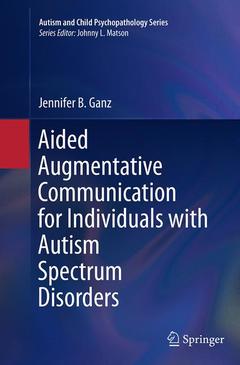Description
Aided Augmentative Communication for Individuals with Autism Spectrum Disorders, 2014
Autism and Child Psychopathology Series
Author: Ganz Jennifer B.
Language: English
Subjects for Aided Augmentative Communication for Individuals with...:
Keywords
AAC and autism spectrum disorders; ASD and communication skills; Aided language stimulation; Assessment and treatment of ASD; Augmentative and alternative communication; Challenging behaviors and autism; Complex communication needs and ASD; Computerized communication devices and autism; FCT and AAC; Facilitated communication; Functional communication training with aided AAC; Manual sign language; PECS and ASD; Picture Exchange Communication System (PECS); SGDs and autism spectrum disorders; Speech-generating devices and ASD; Speech-language pathology and ASD; VOCA and autism spectrum disorders
Publication date: 09-2016
Support: Print on demand
Publication date: 05-2014
141 p. · 15.5x23.5 cm · Hardback
Description
/li>Contents
/li>Biography
/li>Comment
/li>
Just as autism is a continuum of disorders, it is associated with a broad range of neurodevelopmental, social, and communication deficits. For individuals with autism spectrum disorders (ASD), augmentative and alternative communication (AAC) has a major impact on their daily lives, often reducing the occurrence of challenging behaviors.
Aided Augmentative Communication for Individuals with Autism Spectrum Disorders is a practical guide to the field, offering readers a solid grounding in ASD, related complex communication needs (CCN), and AAC, especially visual and computer-based technologies. Widely used interventions and tools in AAC are reviewed?not just how they work, but why they work?to aid practitioners in choosing those most suited to individual clients or students. Issues in evaluation for aided AAC and debates concerning its usability round out the coverage. Readers come away with a deeper understanding of the centrality of communication for clients with ASD and the many possibilities for intervention.
Key areas of coverage include:
- AAC and assessment of people with ASD and CCN.
- Interdisciplinary issues and collaboration in assessment and treatment.
- AAC intervention mediated by natural communication partners.
- Functional communication training with AAC.
- The controversy surrounding facilitated communication.
- Sign language versus AAC.
Aided Augmentative Communication for Individuals with Autism Spectrum Disorders is an essential resource for clinicians/practitioners, researchers, and graduate students in such fields as child and school psychology, speech pathology, language education, developmental psychology, behavior therapy, and educational technology.
Part 1: Introduction and Overview.- Chapter 1: Overview of Autism Spectrum Disorders and Complex Communication Needs.- Chapter 2: Aided Augmentative and Alternative Communication: An Overview.- Chapter 3: AAC and Assessment of People with ASD and CCN.- Chapter 4: Interdisciplinary Issues and Collaboration in Assessment and Treatment.- Part 2:Interventions and Techniques to Provide Aided AAC for People with ASD.- Chapter 5: Naturalistic Aided AAC Instruction.- Chapter 6: AAC Intervention Mediated by Natural Communication Partners.- Chapter 7: Functional Communication Training with AAC.- Part 3: Controversial Issues in AAC.-Chapter 8: The Controversy Surrounding Facilitated Communication .- Chapter 9: Sign Language versus Aided AAC.




